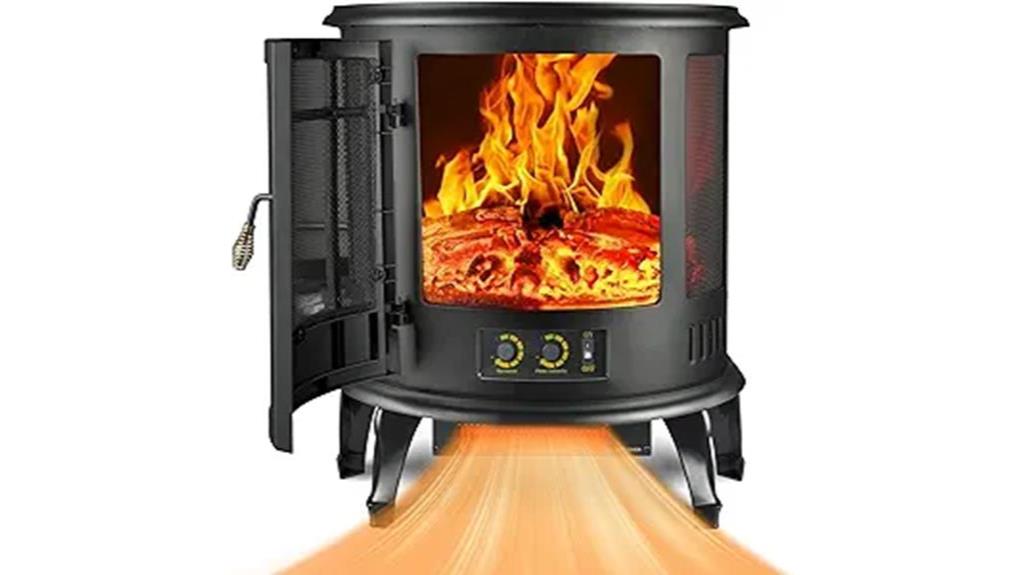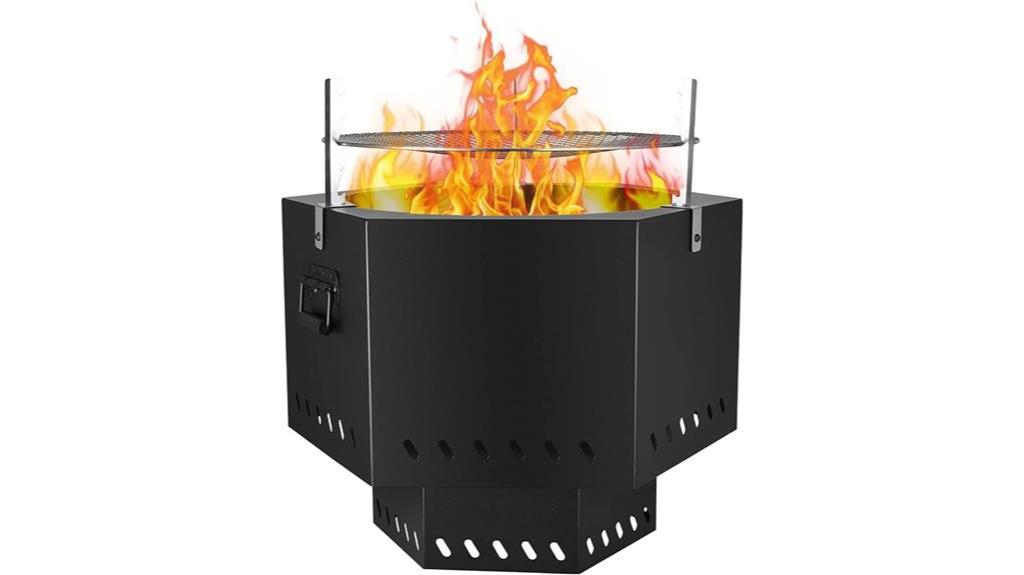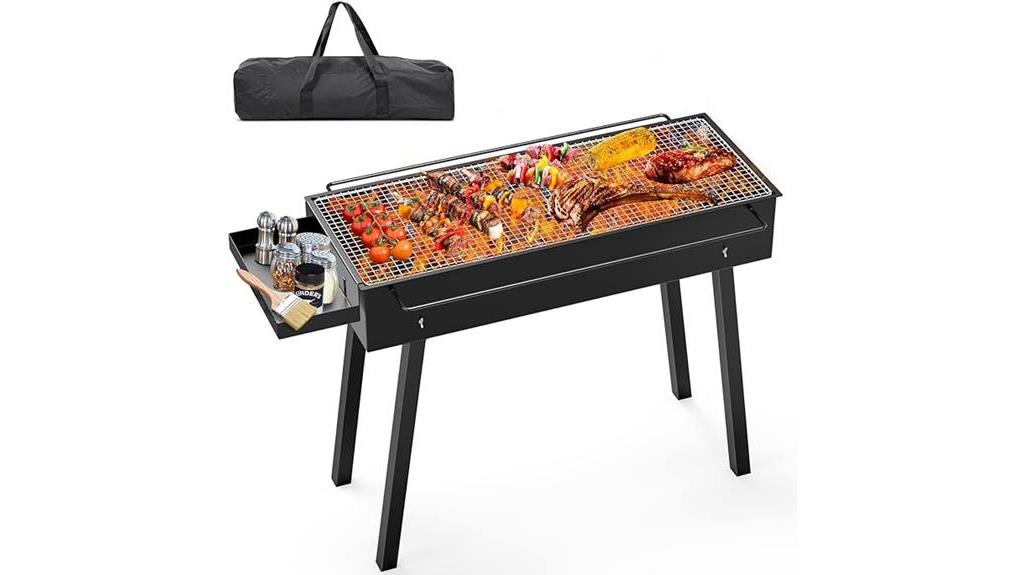Wood Stove
How To Install Wall Thimble For A Wood Stove

Being a person who cherishes peaceful evenings by the fire, I understand the importance of properly installing a wood stove. Therefore, I am committed to helping you with the installation of a wall thimble for your wood stove.
In this detailed and informative article, I’ll share step-by-step instructions, ensuring you choose the right thimble and take the necessary safety measures.
Get ready to enhance your home’s warmth and ambiance with a professionally installed wood stove.
Key Takeaways
- Building codes and clearances must be considered for proper operation and safety of the wood stove installation.
- The size of the wall thimble should match the diameter of the stovepipe, following manufacturer’s guidelines and local building codes.
- Gathering the necessary tools and materials, such as tape measure, level, saw, drill, wall thimble kit, chimney pipe, sealant, and insulation, is crucial for a successful installation.
- Proper ventilation, correct installation height and angle, and regular maintenance are essential for ensuring efficient and safe operation of the wood stove.
Choosing the Right Wall Thimble for Your Wood Stove
What is the best wall thimble for my wood stove?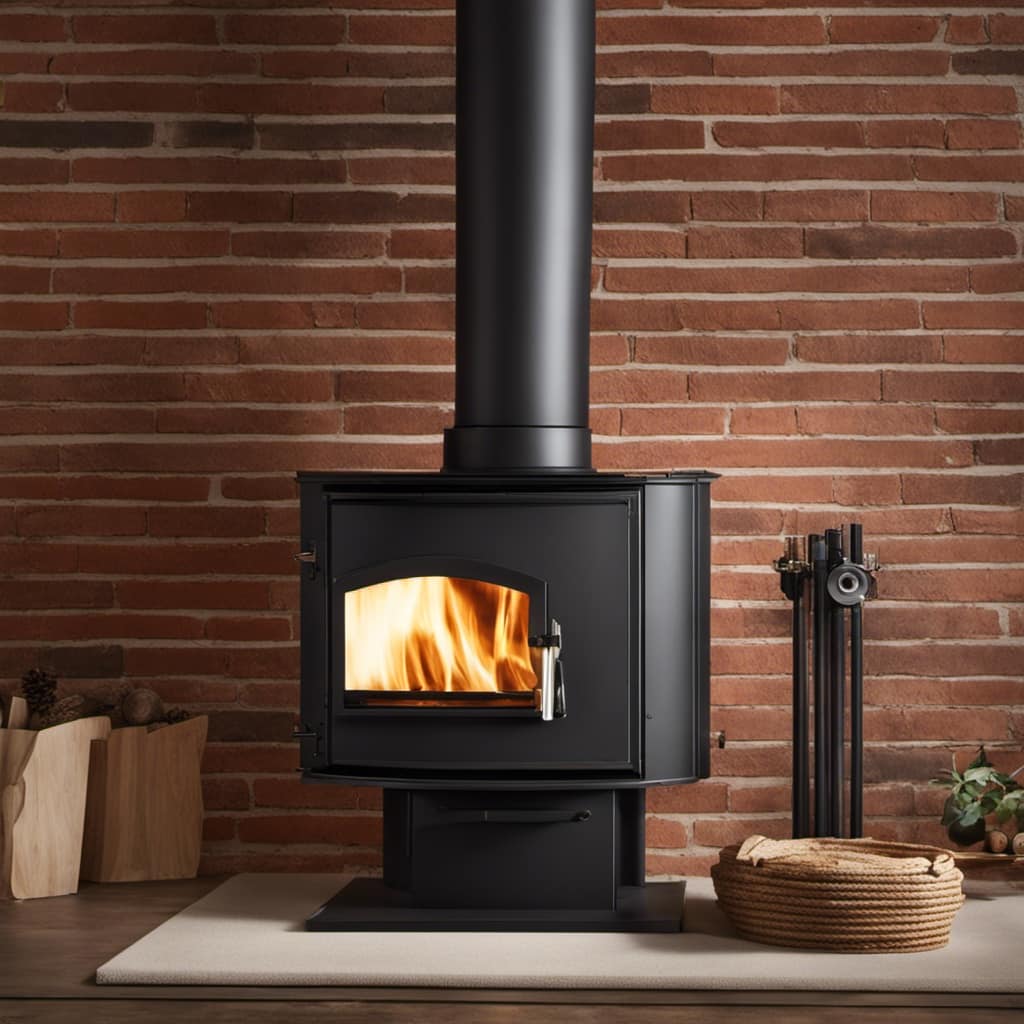
When choosing the right size wall thimble for your wood stove installation, it’s crucial to consider the building codes in your area. Building codes dictate the minimum clearances required between the stove and combustible materials, as well as the necessary ventilation for proper operation.
The size of the wall thimble should match the diameter of the stovepipe, ensuring a proper fit and efficient exhaust flow. It’s important to consult the manufacturer’s guidelines and local building codes to determine the appropriate size for your specific wood stove.
Additionally, some wall thimbles may have insulation or fireproofing features, providing an extra layer of safety. Understanding and adhering to building codes will ensure a safe and effective wood stove installation.
Gathering the Necessary Tools and Materials
How can I gather all the necessary tools and materials for this wood stove installation? It’s important to be prepared when installing a wood stove, and having the right tools and materials is essential. Here are some steps to help you gather everything you need:
Make a list of tools: You’ll need a tape measure, level, stud finder, reciprocating saw, and a drill with various drill bits.
Gather the materials: Get a wall thimble kit, chimney pipe, stovepipe, high-temperature silicone sealant, and fireproof insulation.
Prepare the wood stove area: Clear out any debris and ensure the area is clean and level.
Measure the wall thickness: Use a tape measure to determine the thickness of the wall where the thimble will be installed.
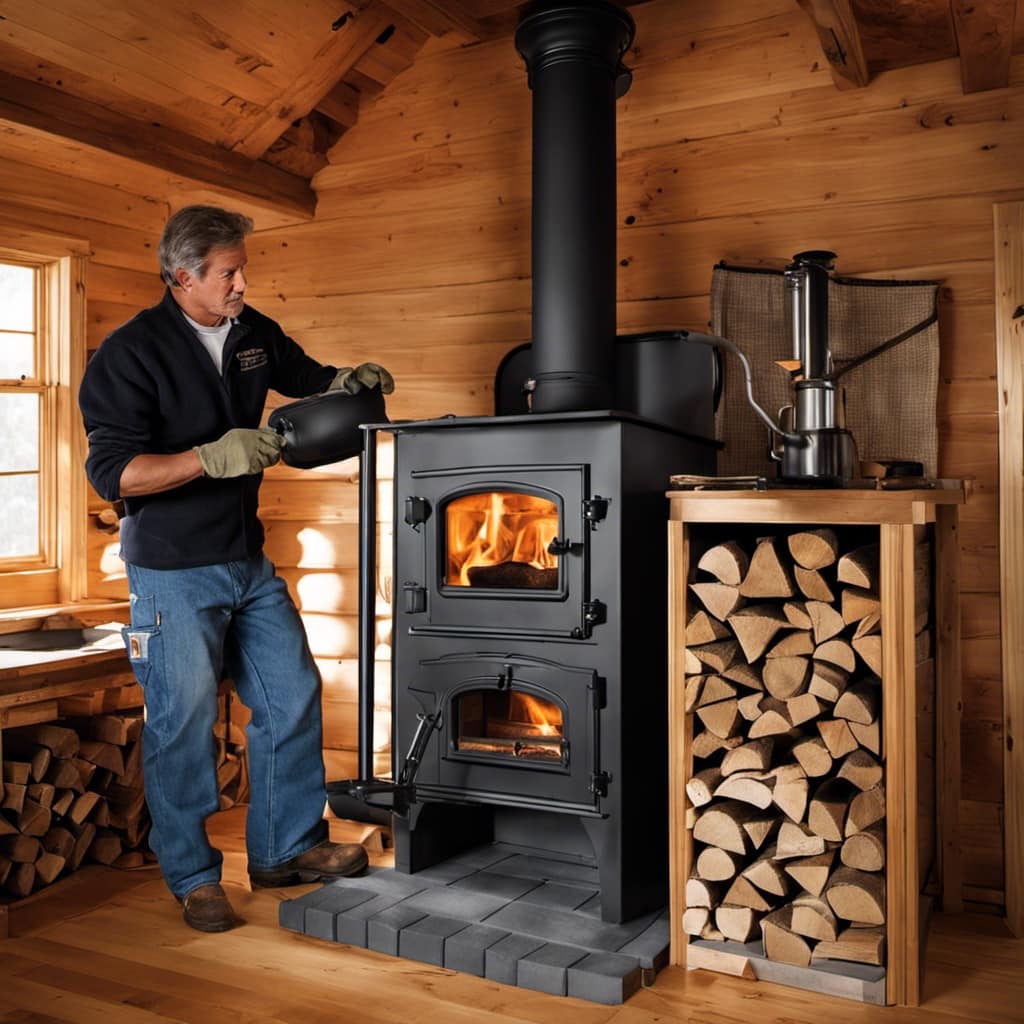
Preparing the Wall for Thimble Installation
I am ensuring the proper alignment and stability of the wall before proceeding with thimble installation. Wall preparation is crucial to ensure a safe and efficient installation of your wood stove.
First, I thoroughly inspect the wall for any signs of damage or weakness.
Next, I measure the area where the thimble will be installed, ensuring accuracy to avoid any gaps or misalignments. It’s important to follow the manufacturer’s guidelines for wall thickness and clearance requirements.
I mark the measurements on the wall and use a level to ensure everything is straight.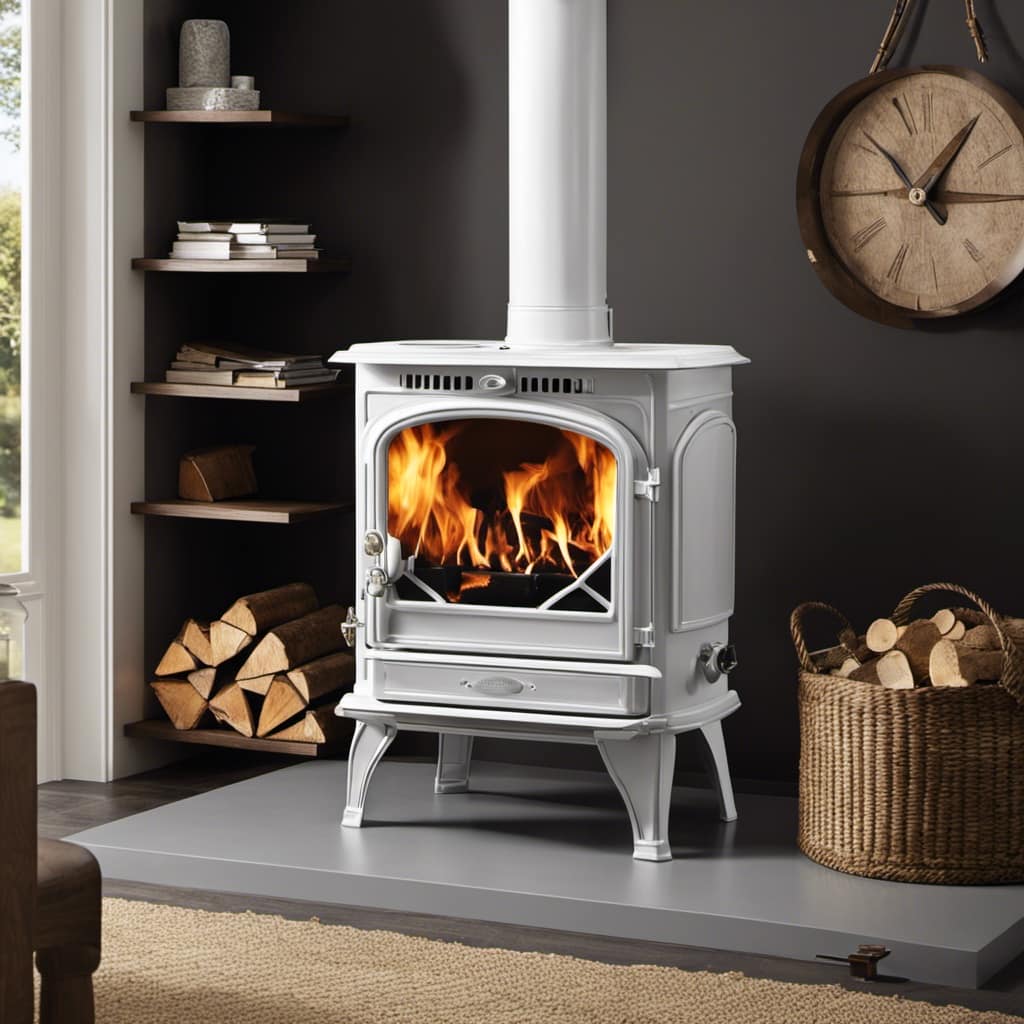
Once I’m confident that the wall is properly prepared, I can proceed with installing the wall thimble for your wood stove, ensuring a secure and efficient connection.
Installing the Wall Thimble for Your Wood Stove
After thoroughly preparing the wall, I can now securely install the wall thimble for your wood stove. Installing the wall thimble correctly is crucial for the safe and efficient operation of your wood stove. Here are some key steps to follow:
- Measure and mark the exact location for the thimble on the wall.
- Use a hole saw to cut a hole through the wall at the marked location.
- Insert the thimble into the hole, ensuring a snug fit.
- Secure the thimble in place using screws or brackets.
Troubleshooting common installation issues:
- If the thimble doesn’t fit properly, check if the hole is the correct size and shape.
- Ensure that the thimble is level and centered within the hole.
- Double-check the tightness of the screws or brackets to prevent any movement.
Correctly installing the wall thimble is essential for the proper functioning and safety of your wood stove.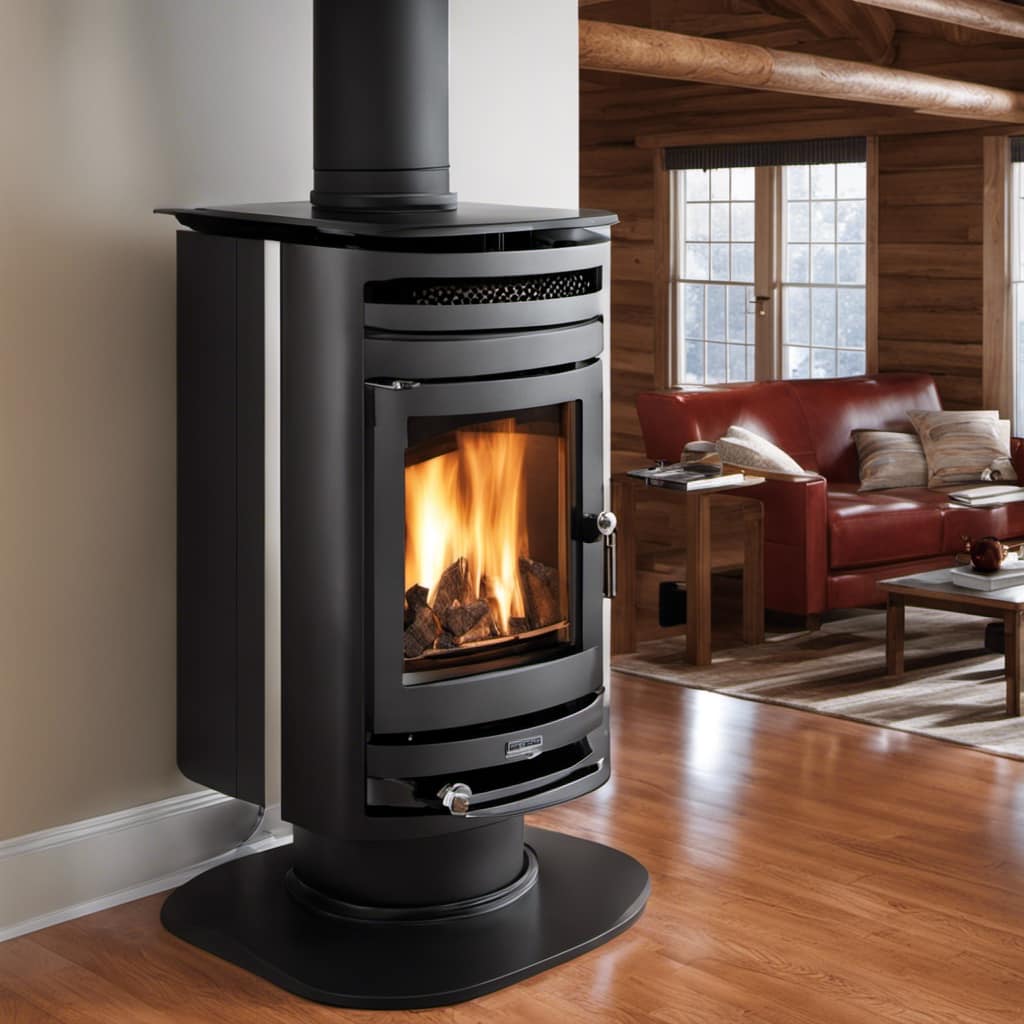
Can I Use the Same Wall Thimble Installation for a Wood Stove Chimney in a Cathedral Ceiling?
Yes, you can install a wood stove chimney through the floor in a cathedral ceiling with the same wall thimble installation. Ensure the thimble is properly sealed and insulated to prevent any heat transfer to combustible materials. It’s important to follow local building codes and manufacturer recommendations for safe installation.
Ensuring Proper Ventilation and Safety Measures
To ensure proper ventilation and safety measures, it’s important to carefully follow the steps for installing the wall thimble.
When it comes to wood stoves, regular maintenance is crucial for their efficient and safe operation. One of the key components in the installation process is the wall thimble, which allows the stove pipe to pass through the wall while maintaining a proper seal.
However, there are some common mistakes that should be avoided during the installation.
- Firstly, ensure that the wall thimble is properly sized for your stove pipe.
- Secondly, make sure that the thimble is installed at the correct height and angle to ensure proper draft and prevent smoke from entering your home.
- Lastly, always double-check the tightness of the connections to prevent any leaks.
Frequently Asked Questions
How Long Does It Typically Take to Install a Wall Thimble for a Wood Stove?
Typically, it takes a few hours to install a wall thimble for a wood stove. To choose the right size, measure the stove’s pipe diameter. Common mistakes to avoid include improper sealing and insufficient clearance from combustible materials.
Can a Wall Thimble Be Installed on Any Type of Wall Material?
Sure, a wall thimble can be installed on any type of wall material. However, it’s important to consider the installation process and ensure that the wall material is suitable for proper support and ventilation.
Are There Any Specific Clearance Requirements for the Wall Thimble Installation?
When installing a wall thimble, it is crucial to adhere to the proper clearance requirements. These guidelines ensure the safe and effective installation of the thimble, preventing any potential hazards or damage to the surrounding walls.
Can a Wall Thimble Be Installed Without Professional Help?
Yes, a wall thimble can be installed without professional help. However, it is recommended to hire a professional for the installation due to the complexity and potential risks involved. Hiring a professional ensures safety and proper installation.
Is It Necessary to Remove the Wood Stove From the Wall in Order to Install the Wall Thimble?
Yes, it is possible to install a wall thimble without removing the wood stove from the wall. However, it is important to ensure that the installation process does not damage the wall.
Conclusion
As the final piece in the installation puzzle, the wall thimble for your wood stove is crucial for ensuring proper ventilation and safety.
By choosing the right thimble, gathering the necessary tools and materials, and preparing the wall, you can easily install this vital component.
Remember to follow the guidelines and take all necessary safety precautions.
With the wall thimble in place, you can enjoy the warmth and comfort of your wood stove with confidence and peace of mind.
Growing up surrounded by the vast beauty of nature, Sierra was always drawn to the call of the wild. While others sought the comfort of the familiar, she ventured out, embracing the unpredictable and finding stories in the heartbeat of nature.
At the epicenter of every remarkable venture lies a dynamic team—a fusion of diverse talents, visions, and passions. The essence of Best Small Wood Stoves is crafted and refined by such a trio: Sierra, Logan, and Terra. Their collective expertise has transformed the platform into a leading authority on small wood stoves, radiating warmth and knowledge in equal measure.
Wood Stove
How To Remove Bottom Wood Stove Door Pin

- Proper maintenance for wood stoves
- Common problems with wood stove doors and how to fix them
I have always enjoyed the comforting heat that a wood stove provides. However, when the pin in the lower door of my stove began to stick, it became a frustrating hindrance.
After some trial and error, I discovered a simple solution to remove the pin and get my wood stove back in working order. In this article, I’ll share step-by-step instructions on how to remove the bottom wood stove door pin, so you can keep enjoying the comforting heat without any hassle.
Key Takeaways
- Proper maintenance is crucial for wood stove efficiency and safety
- Removing the bottom door pin is necessary to fix loose or stuck pins
- Use a screwdriver to unscrew the bottom pin counterclockwise
- Apply lubricant to the pin and hinge area to facilitate easier removal
Tools and Materials Needed
I’ll need a screwdriver for removing the bottom wood stove door pin.
Proper maintenance for wood stoves is crucial to ensure their efficiency and safety. One common problem that wood stove owners often encounter is difficulty with their stove doors.
Over time, the door pins may become loose or stuck, making it challenging to open or close the door properly. To fix this issue, removing the bottom door pin is necessary.
First, locate the pin at the bottom hinge of the door. Then, using a screwdriver, carefully unscrew the pin counterclockwise until it’s completely removed.
This will allow you to inspect and clean the pin, as well as the hinge, ensuring smooth operation and preventing further problems.
Step 1: Preparing the Wood Stove Door
To begin, carefully remove the door handle and set it aside. Then use a screwdriver to loosen the screws attaching the door to the stove. Once the screws are removed, gently lift the door off its hinges and place it on a flat surface.

Now, let’s move on to preparing the surface for cleaning.
-
Start by wiping away any loose dirt or debris from the door using a dry cloth. This will ensure a clean starting point for the cleaning process.
-
Next, mix a solution of warm water and mild dish soap in a bucket. Dip a sponge or scrub brush into the soapy water and gently scrub the surface of the door, paying special attention to any stubborn stains or grime.
-
After scrubbing, rinse the door thoroughly with clean water and wipe it dry with a clean cloth or towel.

Following these steps will help you prepare the surface of your wood stove door for the cleaning process, ensuring a clean and well-maintained door.
Step 2: Loosening the Bottom Pin
I’ll use a screwdriver to loosen the screws, and then gently lift the door off its hinges.
When it comes to removing the bottom pin of a wood stove door, it’s essential to use the right technique to avoid any damage.
The loosening technique involves carefully unscrewing the screws that hold the bottom pin in place. It’s crucial to ensure that the screwdriver fits properly into the screw heads to avoid stripping them.
Applying gentle pressure while turning the screwdriver counterclockwise will gradually loosen the screws. It’s important not to force the screws as this can lead to damage.
Common mistakes to avoid include using the wrong size screwdriver or applying excessive force, which can result in stripped screws or even breakage.
Step 3: Removing the Bottom Pin
I carefully grasp the pliers and begin to gently twist, using them to unscrew the bottom pin from its slot. Removing the pin safely is an important step in troubleshooting common issues with wood stove doors.
Here are three key points to consider:
-
Inspect the pin for any signs of damage or wear. If the pin is bent or corroded, it may need to be replaced to ensure a proper fit and functionality.
-
Apply lubricant to the pin and hinge area to facilitate smoother removal. This will help reduce friction and make it easier to unscrew the pin from its slot.
-
Use steady and controlled force when twisting the pliers. Avoid applying excessive pressure, as this can damage the pin or hinge. Gradually loosen the pin until it comes out completely.
With the bottom pin successfully removed, we can now move on to the next step: reattaching the wood stove door.
Step 4: Reattaching the Wood Stove Door
After carefully aligning the hinges, I firmly secure the wood stove door back in place. Reattaching the wood stove door is an essential step in maintaining the functionality and safety of your wood stove.
When it comes to reattaching techniques, there are a few common mistakes that people often make. One of the most common mistakes isn’t properly aligning the hinges before securing the door. This can lead to an ill-fitting door that doesn’t close properly and allows air to escape, reducing the efficiency of your wood stove.
Another mistake isn’t using the correct size or type of screws to secure the door. Using screws that are too short or too long can compromise the door’s stability and pose a safety risk. It’s important to use screws that are specifically designed for wood stove doors.
Frequently Asked Questions
How Often Should the Bottom Wood Stove Door Pin Be Removed and Cleaned?
I recommend cleaning the bottom wood stove door pin annually. It’s important to use the proper tool to remove it, as using a different tool may cause damage.

Can I Use a Regular Screwdriver to Loosen the Bottom Pin?
Yes, you can use a regular screwdriver to loosen the bottom pin on a wood stove door. However, it is important to be cautious and make sure the screwdriver fits properly to avoid damage.
Is It Necessary to Remove the Bottom Pin to Clean the Wood Stove Door?
To properly clean a wood stove door without removing the bottom pin, you can use a vacuum or brush to remove any loose debris. Additionally, wiping it down with a damp cloth and mild detergent can help maintain its cleanliness.
Can I Replace the Bottom Pin With a Different Type of Pin?
Yes, you can replace the bottom pin with a different type of pin. There are various alternatives available that can be used to secure the wood stove door effectively.
How Do I Know if the Bottom Pin Is Damaged and Needs to Be Replaced?
To determine if the bottom pin is damaged and needs replacing, inspect it for any signs of wear, such as rust, bent or broken parts, or difficulty in opening and closing the door. Troubleshoot any issues accordingly.
Conclusion
Well, congratulations! You have now successfully learned the art of removing a bottom wood stove door pin.
With your newfound knowledge and skill, you can impress your friends and family with your ability to dismantle a wood stove door.
Just remember, with great power comes great responsibility. So, use your newfound expertise wisely and enjoy the warmth and coziness that your wood stove brings.
Happy pin removing!
Growing up surrounded by the vast beauty of nature, Sierra was always drawn to the call of the wild. While others sought the comfort of the familiar, she ventured out, embracing the unpredictable and finding stories in the heartbeat of nature.
At the epicenter of every remarkable venture lies a dynamic team—a fusion of diverse talents, visions, and passions. The essence of Best Small Wood Stoves is crafted and refined by such a trio: Sierra, Logan, and Terra. Their collective expertise has transformed the platform into a leading authority on small wood stoves, radiating warmth and knowledge in equal measure.
Wood Stove
How To Make A Wood Stove Gravity Fed

I have always appreciated the comfortable warmth that a wood stove provides, but I wanted to improve upon that experience.
That’s when I discovered the incredible world of gravity fed wood stoves. Imagine effortlessly feeding logs into your stove, as if it were magic.
In this article, I’ll share my knowledge and guide you through the process of making your own gravity fed wood stove.
Get ready to elevate your wood burning experience to new heights.
Key Takeaways
- Understanding the basics of a gravity fed wood stove, including the firebox, heat exchanger, and chimney components.
- Advantages of using a gravity fed wood stove, such as cost-effectiveness and steady heat output during power outages.
- Disadvantages of using a gravity fed wood stove, such as the risk of chimney fires and difficulty in controlling heat output.
- Considerations for choosing the right wood stove, including efficiency, size and capacity, design and construction, and air control features.
Understanding the Basics of a Gravity Fed Wood Stove
I’ve learned the three main components of a gravity fed wood stove: the firebox, the heat exchanger, and the chimney. A gravity fed wood stove works by utilizing the natural flow of hot air and gases.
The firebox is where the wood is burned, creating heat. The heat exchanger is a series of pipes or tubes that surround the firebox, allowing the heat to transfer to the surrounding air or water. The chimney is responsible for drawing the smoke and gases out of the stove and expelling them outside.
There are several advantages to using a gravity fed wood stove. Firstly, it’s a cost-effective heating solution, as it utilizes renewable resources such as wood. Additionally, it provides a steady and consistent heat output, even when the power is out.
However, there are a few disadvantages as well. One common issue with gravity fed wood stoves is the buildup of creosote in the chimney, which can lead to chimney fires. Regular cleaning and maintenance can help prevent this. Another common issue is the difficulty in controlling the heat output, as it relies on the natural flow of air.
Overall, understanding the basics of a gravity fed wood stove and troubleshooting common issues can ensure its efficient and safe operation.
Choosing the Right Wood Stove for Your Gravity Fed System
To ensure optimal performance, it’s important to research and compare different wood stove options before selecting the right one for your gravity fed system. Wood stove efficiency plays a crucial role in determining the heating capacity and fuel consumption of your system.
Here are some advantages of gravity fed systems and factors to consider when choosing a wood stove:
-
Efficiency: Look for stoves with high efficiency ratings to maximize heat output and minimize fuel usage.

-
Size and Capacity: Consider the size of your space and the heating requirements to choose a stove that can adequately heat the area.
-
Design and Construction: Look for stoves made with durable materials and a well-designed combustion chamber for efficient heat transfer.
-
Air Control: Opt for a stove with adjustable air vents to control the combustion process and maintain optimal burning conditions.
Building a Reliable Gravity Feeding Mechanism
I’m currently researching different materials to use in building a reliable gravity feeding mechanism for my wood stove. Designing a gravity fed mechanism for a wood stove is crucial for ensuring a consistent and efficient heat supply. The mechanism should allow for a steady flow of fuel into the firebox without the need for constant manual intervention.

When designing the gravity fed mechanism, there are a few key factors to consider. First, the material used should be durable and resistant to high temperatures. Stainless steel or cast iron are commonly used for their strength and heat resistance.
Second, the design should promote a smooth and uninterrupted flow of fuel. This can be achieved through the use of gravity-activated doors or hoppers.
Finally, it’s important to troubleshoot common issues such as fuel bridging, where the fuel gets stuck and prevents proper feeding. This can be addressed by incorporating agitators or augers to break up any clumps.
Installing and Setting Up Your Gravity Fed Wood Stove
When installing and setting up your gravity fed wood stove, it’s important to carefully position the stovepipe to ensure proper ventilation and to prevent any backdrafts. The gravity feed mechanism relies on the natural flow of air and the force of gravity to feed the wood into the stove.
Here are some key considerations for a successful gravity stove installation:
- Place the stovepipe in a vertical position, allowing for an uninterrupted flow of air and preventing any potential blockages.
- Ensure that the stovepipe is securely attached to both the stove and the chimney to prevent any leaks or disconnections.
- Position the stove in a central location, away from any combustible materials, and provide a clear space around it for easy access and maintenance.
- Install a chimney cap to prevent rain, debris, and animals from entering the chimney and causing any blockages.
Tips and Maintenance for Efficiently Operating Your Gravity Fed Wood Stove
I’ve found that regularly cleaning the ash and soot buildup from my gravity fed wood stove, and ensuring proper air circulation, really helps maintain its efficiency. To maintain optimal heat, it’s important to clean out the ash and soot buildup from the firebox and chimney at least once a week. This prevents any obstruction that can limit the flow of air and heat.
Additionally, checking the air vents and ensuring they’re open and unobstructed allows for proper combustion and heat transfer. Troubleshooting common issues such as poor heat output or difficulty in starting the fire can often be resolved by checking the wood quality and moisture content. Using dry, seasoned wood is essential for efficient burning and optimal heat production.
Regular maintenance and troubleshooting will ensure your gravity fed wood stove operates at its best, keeping you warm and cozy during the colder months.

Frequently Asked Questions
How Much Wood Do I Need to Burn in a Gravity Fed Wood Stove Each Day?
I burn around X amount of wood per day in my gravity fed wood stove. Its burning efficiency allows for longer burn times compared to other alternative heating methods, making it a cost-effective option.
Can I Use Any Type of Wood in a Gravity Fed Wood Stove?
Yes, you can use different types of wood in a gravity fed wood stove. Hardwoods like oak and maple burn longer and produce more heat, while softwoods like pine burn faster but may leave more residue.
How Long Does It Take for the Gravity Feeding Mechanism to Start Working After Lighting the Stove?
After lighting the stove, it typically takes around 15-30 minutes for the gravity feeding mechanism to start working. To troubleshoot common issues, ensure proper airflow and fuel placement. Regularly clean the stove to maintain efficiency.
Is It Possible to Adjust the Temperature of a Gravity Fed Wood Stove?
Yes, it is possible to adjust the temperature of a gravity fed wood stove. The benefit of these stoves is their self-regulating nature, allowing for easy control of the heat output without the need for electricity or manual adjustments.
Can I Use a Gravity Fed Wood Stove as the Primary Heating Source for My Entire House?
Yes, a gravity fed wood stove can be used as the primary heating source for your entire house. It provides efficient heat distribution and can be a cost-effective alternative to other heating options.
Conclusion
In the world of wood stoves, a gravity fed system is a game-changer. With its reliable feeding mechanism and efficient operation, it’s like having a loyal companion by your side, keeping you warm and cozy.
So, why settle for anything less than the best? By understanding the basics, choosing the right stove, and following proper installation and maintenance, you can experience the magic of a gravity fed wood stove and embrace the warmth it brings.
Growing up surrounded by the vast beauty of nature, Sierra was always drawn to the call of the wild. While others sought the comfort of the familiar, she ventured out, embracing the unpredictable and finding stories in the heartbeat of nature.
At the epicenter of every remarkable venture lies a dynamic team—a fusion of diverse talents, visions, and passions. The essence of Best Small Wood Stoves is crafted and refined by such a trio: Sierra, Logan, and Terra. Their collective expertise has transformed the platform into a leading authority on small wood stoves, radiating warmth and knowledge in equal measure.
Wood Stove
How Far To Put Stuff Marine Wood Stove

I have learned that it is crucial to carefully arrange items on a marine wood stove to guarantee safety and avoid the risk of overheating.
Did you know that the distance between cookware and the stove can greatly affect the cooking process?
In this article, I’ll share my expertise on the recommended distance for placing items on a marine wood stove, as well as guidelines for handling flammable objects.
By organizing and arranging items properly, you can maximize the efficiency and safety of your marine wood stove.
Key Takeaways
- Overloading the stove can lead to overheating and potential damage.
- Maintaining a balance between functionality and safety is important.
- Following manufacturer’s guidelines for recommended distance reduces the risk of accidents or burns.
- Placing flammable objects at least three feet away from the stove ensures safety.
Safety Considerations for Placing Items on a Marine Wood Stove
As I discuss safety considerations for placing items on a marine wood stove, I must be careful not to overload it. When it comes to placement precautions, it’s essential to remember that the stove needs proper heat distribution to function efficiently and prevent any potential hazards.
Placing too many items on the stove can restrict the airflow, leading to overheating and potential damage. It’s important to maintain a balance between functionality and safety. By ensuring that there’s enough space around the stove, heat can circulate properly, reducing the risk of overheating and fire.
Now that we understand the importance of proper placement, let’s move on to the recommended distance for placing cookware on a marine wood stove.
Recommended Distance for Placing Cookware on a Marine Wood Stove
While considering the recommended distance for placing cookware on a marine wood stove, I must prioritize safety and proper heat distribution. As an experienced sailor, I understand the importance of maintaining a safe environment in the galley.
When it comes to proper placement of cookware on a marine wood stove, there are a few key factors to consider.
Firstly, it’s crucial to follow the manufacturer’s guidelines regarding recommended distance. This ensures that the cookware isn’t too close to the flames, reducing the risk of accidents or burns.
Additionally, proper heat distribution is essential for even cooking. By placing the cookware at the recommended distance, the heat can circulate evenly around the pot or pan, resulting in delicious and well-cooked meals.
Guidelines for Placing Flammable Items Near a Marine Wood Stove
I always make sure to follow the recommended guidelines and avoid placing any flammable items near the marine wood stove. Safety precautions are of utmost importance when it comes to using a marine wood stove.

Flammable materials, such as paper, cloth, or plastic, should never be placed near the stove as they can easily catch fire and pose a serious risk. It’s essential to keep a clear area around the stove, ensuring that no flammable objects are within the recommended distance. By doing so, we can greatly minimize the risk of accidental fires and ensure the safety of everyone on board.
Now, let’s discuss how to prevent overheating by placing objects properly on a marine wood stove.
How to Prevent Overheating by Placing Objects Properly on a Marine Wood Stove
To prevent overheating, I always ensure that objects are placed properly on the marine wood stove, following the recommended guidelines. This is crucial for preventing accidents and maintaining a safe temperature in the boat.
Placing objects too close to the stove can result in overheating and potentially starting a fire. Therefore, it’s important to maintain a clear space around the stove, keeping flammable items at a safe distance.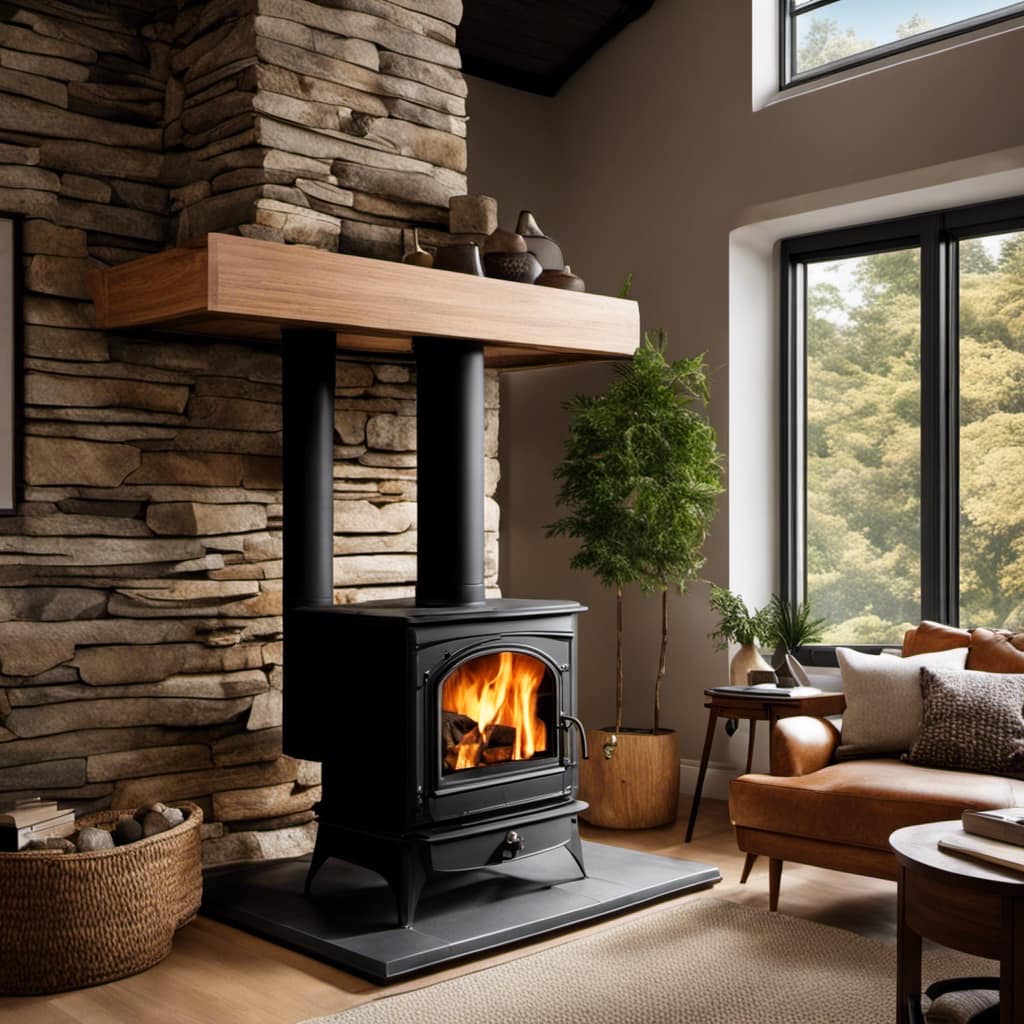
Additionally, it’s essential to use appropriate cookware and utensils that are designed for use on a marine wood stove. This helps to distribute the heat evenly and prevents any potential damage to the stove or surrounding areas.
Best Practices for Organizing and Arranging Items on a Marine Wood Stove
When organizing and arranging items on a marine wood stove, it is important to be mindful of the space around and above the stove, ensuring that objects are not only placed properly but also kept clear from potential hazards. As an experienced sailor, I have learned the best practices for organizing utensils, cleaning, and maintenance on a marine wood stove. One effective way to keep everything in order is by utilizing a table. Here is an example of how I arrange and organize items on my marine wood stove:
| Column 1 | Column 2 | Column 3 |
|---|---|---|
| Utensils | Cleaning Tools | Maintenance |
| Pots and pans | Sponge | Chimney sweep |
| Cooking tools | Dishcloth | Gasket check |
| Plates and cups | Scrub brush | Ventilation |
Frequently Asked Questions
Can I Place Non-Cookware Items on a Marine Wood Stove?
Yes, you can place non-cookware items on a marine wood stove, but it is not recommended. To ensure safety, it is best to only use the stove for cooking purposes and follow the manufacturer’s guidelines.
What Is the Maximum Weight Limit for Cookware on a Marine Wood Stove?
The maximum weight limit for cookware on a marine wood stove is important to consider. It’s crucial to follow the recommended distance for placing cookware to ensure safety and optimal performance.
Is It Safe to Place Plastic or Rubber Items Near a Marine Wood Stove?
I can use a marine wood stove for cooking food. It is safe to place certain materials near it, such as metal or ceramic. However, it is not recommended to place plastic or rubber items near the stove due to the risk of melting or catching fire.
Can I Use a Marine Wood Stove for Heating Purposes Only?
Yes, you can use a marine wood stove for heating purposes only. It’s important to consult the marine wood stove installation guide for proper placement and safety. The advantages of using a marine wood stove for heating include efficiency and a cozy atmosphere.
How Often Should I Rearrange the Items on a Marine Wood Stove to Prevent Overheating?
When it comes to preventing overheating on a marine wood stove, it’s crucial to consider how the placement of items affects heating efficiency. Following best practices for arranging items can help maintain a safe temperature.
Conclusion
In conclusion, placing items on a marine wood stove requires careful consideration for safety. It’s recommended to maintain a safe distance between cookware and the stove to prevent accidents. Additionally, it’s crucial to follow guidelines for keeping flammable items away from the stove to avoid potential fires. By properly organizing and arranging items on the stove, we can prevent overheating and ensure a safe cooking experience on board.
Remember, safety should always be the top priority when using a marine wood stove.
One interesting statistic to note is that according to a study conducted by the National Fire Protection Association, cooking equipment is the leading cause of home fires and fire injuries. Therefore, it’s essential to be knowledgeable and precise in our approach to using a marine wood stove to minimize risks and enjoy our time on the water.
Growing up surrounded by the vast beauty of nature, Sierra was always drawn to the call of the wild. While others sought the comfort of the familiar, she ventured out, embracing the unpredictable and finding stories in the heartbeat of nature.
At the epicenter of every remarkable venture lies a dynamic team—a fusion of diverse talents, visions, and passions. The essence of Best Small Wood Stoves is crafted and refined by such a trio: Sierra, Logan, and Terra. Their collective expertise has transformed the platform into a leading authority on small wood stoves, radiating warmth and knowledge in equal measure.
-

 Wood Stove8 months ago
Wood Stove8 months agoHow To Build A Thermoelectric Generator For A Wood Stove
-

 Wood Stove5 months ago
Wood Stove5 months agoWhat Can I Use As Insulation On Wood Stove Pipes
-

 Wood Stove3 weeks ago
Wood Stove3 weeks agoHow To Use Damper And Draft On Wood Stove
-

 Wood Stove8 months ago
Wood Stove8 months agoHow Far Does Wood Stove Have To Be From Wall
-

 Wood Stove8 months ago
Wood Stove8 months agoHow To Make A Heat Shield For A Wood Stove
-

 Wood Stove2 weeks ago
Wood Stove2 weeks agoWhen To Open And Close Damper On Wood Stove
-

 Wood Stove8 months ago
Wood Stove8 months agoHow To Use The Flue On A Wood Stove
-

 Wood Stove5 months ago
Wood Stove5 months agoHow To Install A Wood Stove Pipe And Chimney






